|
|
|
Sort Order |
|
|
|
Items / Page
|
|
|
|
|
|
|
| Srl | Item |
| 1 |
ID:
185766


|
|
|
|
|
| Summary/Abstract |
With the emergence of modern-day warfare techniques including Grey Zone/ Hybrid Warfare and given the share of budget allocated to the Armed Forces, it has become imperative for Armed Forces personnel to focus on “out of box” thinking and leverage human potential to overcome constraints that we face today. The problem is to promote out of box thinking. The solution lies in fostering one important attribute i.e., imagination. It is important to understand and imagine how to defeat an enemy or how to provide security in your area of responsibility because those thoughts might constitute a starting point for something creative. The article carries out an analysis on how to promote ‘Out of Box’ critical thinking in the Indian Armed Forces and gives a Road map for encouraging and developing out of box critical thinking as part of its culture.
|
|
|
|
|
|
|
|
|
|
|
|
|
|
|
|
| 2 |
ID:
185773
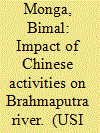

|
|
|
|
|
| Summary/Abstract |
The long-term plans of China for securing natural resources, including water, hold ominous portents for the world at large, and for its neighbouring countries in particular. As far as the trans-border water resources between India and China go, China has an advantage being the upper riparian state. Its plan to dam the Brahmaputra River has particularly rung alarm bells in India. The potential impact of dams, not only on the livelihood and sustenance of the population dependent on the waters of the Brahmaputra River but also on their very existence due to catastrophic earthquakes and floods, is worrisome. Moreover, China’s capability and, arguably, the intent to use water as a weapon, when required, is another aspect India has to be mindful of. It is, therefore, imperative for India to evolve a well ‘thought-out’ and ‘thought-through’ strategy in concert with other lower riparian and like-minded states and international organisations to ensure that its security interests are safeguarded.
|
|
|
|
|
|
|
|
|
|
|
|
|
|
|
|
| 3 |
ID:
185768
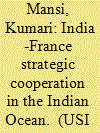

|
|
|
|
|
| Summary/Abstract |
Even before the ‘Indo-Pacific’ narrative, the Indian Ocean has been historically a theatre of human interaction via maritime trade and a pivot of great power rivalry. The strategic location and economic potential of IOR makes it a volatile and troublesome region in the world. The emerging power dynamics in the region and contestation of power, resources, and dominance among the key players of the region— the US, China, Japan, Australia, India, and France, makes this area a dangerous conflict zone. The IOR (IOR) figures prominently in the strategic outlook of India and France who happen to be the main players of this region amid the growing footprint of China in the region. The strategic partnership has now been expanded to include the IOR, and both countries recognise the critical role they can play in maintaining regional peace, security, and stability. The increasing cooperation in the Indian Ocean is a step closer to the convergence in their respective policy towards Indo-Pacific.
|
|
|
|
|
|
|
|
|
|
|
|
|
|
|
|
| 4 |
ID:
185770
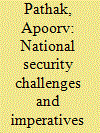

|
|
|
|
|
| Summary/Abstract |
With the Covid-19 pandemic, as the resources are diverted towards medical and social emergencies, an uncharted economic territory necessitates an overall assessment of strategic outlook and subsequent realignment of priorities — in line with available resources. This assessment becomes even more critical at a time when global order is at the cusp of major transformation and India is facing new challenges to its National Security. In spite of its setbacks, the Covid crisis offers the Indian establishment an opportunity to take long pending difficult decisions towards transforming its policy approach and undertaking structural reforms. Through the ‘Atma-Nirbharta’ (Self Sufficiency) policy, India has initiated its movement towards self-dependence in defence manufacturing. However, to meet the future security challenges, a holistic transformation through self-analysis, with ingenious solutions, is the need of the hour.
|
|
|
|
|
|
|
|
|
|
|
|
|
|
|
|
| 5 |
ID:
185772
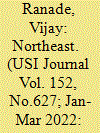

|
|
|
|
|
| Summary/Abstract |
The Northeast holds a treasure trove of natural energy sources in terms of hydel power and wind power and, to a lesser extent, solar power. It also has myriad other natural resources such as coal, tea, timber etc. None can be successfully processed to generate income and employment without power. In addition, the large hydel resources also generate enough power to export to the neighbouring countries and thus give strength to India’s ‘Act East’ Policy. To tap and exploit the full potential of the power sector in the region, we need a multi-pronged approach broken down into achievable phases which encompasses all the sectors of infrastructure, industry, financial outlay, and, importantly, aspirations of the region. Development of the hydro energy sector and especially the renewable power source will integrate the region not only with the national grid but also with South-East Asian countries. The abundance of hydro energy gives us an opportunity to look outwards. The article recommends the actions that must be taken and the road map for development of the power potential of the Northeast. This will also bring prosperity, douse the myriad militant movements, and integrate the region with the rest of the country.
|
|
|
|
|
|
|
|
|
|
|
|
|
|
|
|
| 6 |
ID:
185769
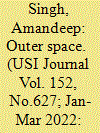

|
|
|
|
|
| Summary/Abstract |
Mankind in outer space has progressed from exploration to exploitation. The future of war and the success of ground forces will be critically dependent upon the effective use of space assets and capabilities across the spectrum of conflict. The coming of space-based systems has added a fourth dimension to modern day warfare and has made it imperative that exploration of space and its dominance have to be concurrently thought about and planned for organisationally.
|
|
|
|
|
|
|
|
|
|
|
|
|
|
|
|
| 7 |
ID:
185767
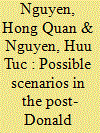

|
|
|
|
|
| Summary/Abstract |
In 2017 US President Donald Trump announced the Free and Open Indo-Pacific (FOIP) strategy to replace the “rebalance” strategy of the predecessor Obama administration. After nearly four years in implementation, the question is, can strategy be continued under the incumbent President Joe Biden? The article carries out an analysis of a number of influencing factors and gives three distinct possible scenarios for US Strategy in the coming times which range from cooperation, ambivalence, and competition. The authors argue that this strategy will be maintained despite some changes in accordance with the domestic and foreign direction of the new Administration.
|
|
|
|
|
|
|
|
|
|
|
|
|
|
|
|
| 8 |
ID:
185765


|
|
|
|
|
| Summary/Abstract |
In the twenty-first century we have seen a shift toward blurring of the lines between the states of war and peace. As we move ahead, we will witness more conflicts and not total all-out wars. The emphasis on achieving outcome of conflicts through non-military means is the new normal. This article examines if we are prepared for that and how should we go about it.
|
|
|
|
|
|
|
|
|
|
|
|
|
|
|
|
| 9 |
ID:
185771


|
|
|
|
|
| Summary/Abstract |
The United Nations Charter (UN) pledges “to save succeeding generations from the scourge of war”.1 The landlocked nation of Afghanistan has been at war for several generations and it is likely — with the present impending humanitarian and socio-economic deficits — the conflict will continue to endure. With Afghanistan ‘hanging by a thread’ post six months of the US pull-out and subsequent Taliban takeover, the world cannot abandon the country now for the sake of its citizens and universal global security. This is also what the UN Secretary-General António Guterres stated when he addressed the UN Security Council (UNSC) on 26 January 2022.2 Historically speaking, the UN has played a pivotal role in Afghanistan ever since the Soviet Union’s military intervention of the 1980s. Scholarly research on civil wars and peace in Afghanistan points to multisided conflict swelling up unchecked and at a threatening pace. The only manner in which the UN can avoid losing much of its twenty years of progress is to chart out a pathway for continued engagement with the Taliban. Hence, there is an urgent need to particularise the UN mission in the country to better mitigate the all-encompassing crises in Kabul.
|
|
|
|
|
|
|
|
|
|
|
|
|
|
|
|
|
|
|
|
|